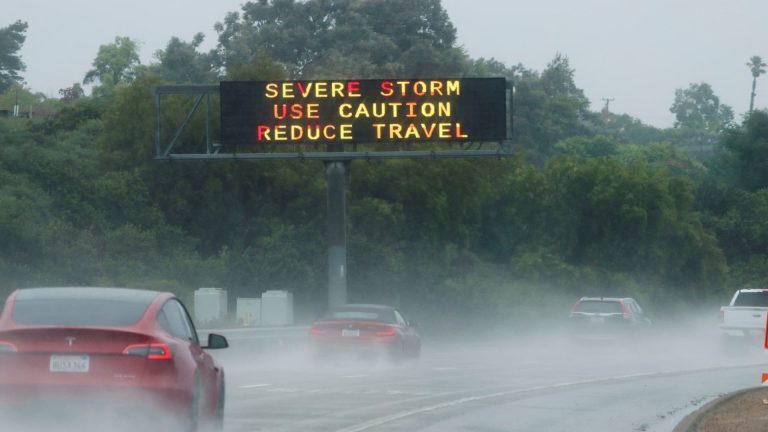Deadly floodwaters inundated streets across Mexico’s arid Baja California on Sunday as Tropical Storm Hilary moved ashore carrying torrential rain into Southern California, and concerns mounted that flash floods could strike in places as far north as Idaho that rarely get such heavy rain.
Forecasters said Hilary was the first tropical storm to hit Southern California in 84 years, bringing the potential for flash floods, mudslides, isolated tornadoes, high winds and power outages.
Hilary made landfall along the Mexican coast in a sparsely populated area about 150 miles (250 kilometers) south of Ensenada, on a path to hit mudslide-prone Tijuana Sunday evening, threatening the improvised homes that cling to hillsides just south of the U.S. border.
At least 9 million people were under flash-flood warnings as heavy rain fell across normally sunny Southern California ahead of the brunt of the storm. Desert areas were especially susceptible along with hillsides with wildfire burn scars, forecasters warned.
Mud spilled onto highways, water overwhelmed drainage systems and tree branches fell in places from San Diego to Los Angeles. The weather service said tornadoes were possible Sunday afternoon in eastern San Diego County.
Southern California got another surprise in the afternoon as an earthquake with a preliminary magnitude of 5.1 hit near Ojai, about 80 miles (130 km) northwest of downtown Los Angeles, according to the U.S. Geological Survey. It was felt widely and was followed by smaller aftershocks. There were no immediate reports of major damage or injury, according to a dispatcher with the Ventura County Sheriff’s Office.
Hilary could wallop other Western states with once-in-a-century rains, with a good chance of it becoming the wettest known tropical cyclone to douse Nevada, Oregon and Idaho. Hilary was expected to remain a tropical storm into central Nevada early Monday before dissipating.
By 2 p.m. California time, Hilary was 115 miles (180 kilometers) south-southeast of San Diego, the National Hurricane Center reported. The storm had maximum sustained winds of 60 mph (95 kph) and was moving northwest at nearly 25 mph (41 kph).
Hurricane Center Director Michael Brennan said that while Hilary had weakened from a Category 4 hurricane, it’s the water, not the wind, that people should watch out for most — some areas could get as much rain in hours as they typically get in a year.
“You do not want to be out driving around, trying to cross flooded roads on vehicle or on foot,” Brennan said during a briefing from Miami. “Rainfall flooding has been the biggest killer in tropical storms and hurricanes in the United States in the past 10 years, and you don’t want to become a statistic.”
Hilary is just the latest major climate disaster to wreak havoc across the U.S., Canada and Mexico. Hawaii’s island of Maui is still reeling from a blaze that killed over 100 people and ravaged the historic town of Lahaina, making it the deadliest U.S. wildfire in more than a century. Firefighters in Canada are battling that nation’s worst fire season on record.
The Mexican cities of Ensenada and Tijuana closed all beaches and opened a half-dozen shelters at sports complexes and government offices.
One person drowned Saturday in the Mexican town of Santa Rosalia when a vehicle was swept away in an overflowing stream. Rescue workers saved four other people, said Edith Aguilar Villavicencio, the mayor of Mulege township.
Mexican army troops fanned out across Mulege, where some of the worst damage occurred Saturday on the eastern side of the Baja Peninsula. Soldiers used bulldozers and dump trucks to help clear tons of boulders and earth-clogging streets and roads that were turned into raging torrents a day earlier.
Power lines were toppled in many places, and emergency personnel were working to restore power and reach those cut off by the storm.
Brennan said rainfall could reach between 3 and 6 inches (7 centimeters and 15 centimeters) in many areas. Forecasters warned it could dump up to 10 inches (25 centimeters) — a year’s worth of rain — in some isolated areas.
California Gov. Gavin Newsom declared a state of emergency. The Federal Emergency Management Agency said it has officials inside California’s emergency preparedness office and teams on standby with food, water and other help.
In coastal Carlsbad, just north of San Diego, 19-year-old Jack Johnson and his friends kept an eye on the waves, determined to surf them at some point Sunday.
“It’s really choppy out there, not really surfable yet, but I think we can find a good break somewhere later,” Johnson said. “I can’t remember a storm like this.”
San Diego schools postponed the first day of classes from Monday to Tuesday.
Authorities issued evacuation warnings Saturday for Santa Catalina Island, urging residents and beachgoers to decamp for the mainland, and for several mountain and foothill communities in San Bernardino County. Orange County sent an alert for anyone living in a wildfire burn scar in the Santa Ana Mountains’ Silverado and Williams canyons.
Los Angeles authorities scrambled to get homeless people off the streets and into shelters, and officials ordered all state beaches in San Diego and Orange counties closed.
Across the region, municipalities ran out of free sandbags and grocery shelves emptied as people stockpiled supplies. California’s Joshua Tree National Park and Mojave National Preserve were closed.
To the north in Nevada, Gov. Joe Lombardo declared a state of emergency and activated 100 National Guard troops to assist with problems from predicted flooding in western Clark and Nye counties and southern Esmeralda County. In Arizona, wind gusts neared 60 mph (97 kph) in Yuma County, where officials gave out thousands of sandbags.
“I urge everyone, everyone in the path of this storm, to take precautions and listen to the guidance of state and local officials,” President Joe Biden said.
Meanwhile, one of several budding storm systems in the Atlantic Ocean became Tropical Storm Emily on Sunday, according to the National Hurricane Center. It was far from land, moving west in the open ocean. Also, Tropical Storm Franklin formed in the eastern Caribbean. Tropical storm watches were issued for the southern coasts of Haiti and the Dominican Republic.
In Sept. 1939, a tropical storm that roared into California ripped apart train tracks, tore houses from their foundations and capsized many boats, killing nearly 100 people on land and at sea.
Read the full article here









